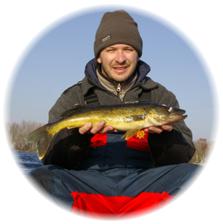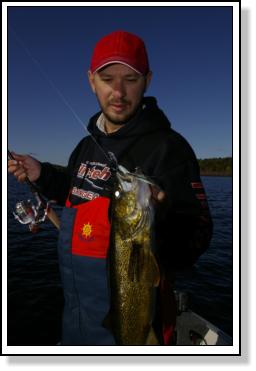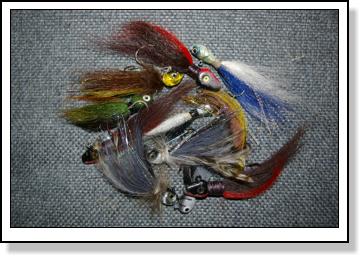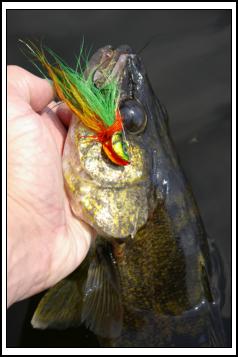
 Bucktail
Jigs for Walleye
Bucktail
Jigs for Walleye
By Justin Hoffman
Feed the fish some fur when working the water for
walleye…
When walleye head to the shade of the salad, or cruise
along the edge of a breakline, a bucktail jig may be
your best tool in the tackle box for seducing a
strategic strike. Regarded as one of the earliest jig
creations to hit the fishing scene, bucktails have
fallen by the wayside over the years, regrettably to
make room for the ever-expanding designs brought on by
the hi-tech plastics market. Those anglers in the know,
however, realize the true value this old standby of fur
can bring to the underwater world, and continue to reap
the benefits season after season.
Working bucktails is a different game than that played
with standard jigs, but the techniques speak for
themselves in the big time rewards you’ll reap in the
bottom of the landing net.
A Breakdown of a Bucktail
A standard bucktail jig is comprised of a lead
(or lead alternative) head, with layers of bucktail tied
and glued to the collar of the bait. The length of this
fur can vary, but a standard bucktail body will average
two to three-inches long. Jigs can be sparsely tied or
plumped up, and are often interwoven with strands of
tinsel – which adds an additional aspect in terms of
visual attraction.
The effectiveness of a bucktail jig comes into play with
the action it produces. When at rest, the hair of a
bucktail jig fans out in the water. This gives an
ever-changing appearance, with the natural movement
being an important triggering factor for walleye. When
jigged, the hair forms a streamlined shape, replicating
the body style and “flight” characteristics of a fleeing
baitfish. Toss in the fact that they are the perfect
snack size for both a finicky or ravenous walleye, and
you’ve got yourself a winning combination.
Rip Jigging with Fur
Rip jigging is a specialized technique that can
often produce big results. The premise is quite simple:
cast or pitch a bucktail jig thirty feet or so, allowing
it to fall on a controlled line, and into any snarls or
clumps of vegetation you may find. Once your bait comes
into contact with the green stuff, a quick snap of the
rod tip will free your jig from the snag, sending it up
and away from the cover. Let it fall back into cover and
repeat.
 With
each rip or jerk, reel up any slack line – this will
allow you to maintain contact with the jig, giving you
the control needed to work the next rip effectively and
efficiently.
With
each rip or jerk, reel up any slack line – this will
allow you to maintain contact with the jig, giving you
the control needed to work the next rip effectively and
efficiently.
Due to the streamlined design of a bucktail jig, it is
relatively weedless when being worked through
vegetation, making it better suited for this style of
fishing than any other jig.
Walleye are an opportunistic feeder. Content to conceal
themselves in the thickest of cover, they will wait for
any unsuspecting baitfish to swim by. The quick nature
of the rip jigging technique forces a walleye to make a
reaction-type strike, or ultimately, go hungry.
Depending on the mood of the fish, they will either
smack the fur as it breaks free from the salad, or rush
forward to engulf it as it slowly and tantalizingly
drops back down. Either way, be prepared to immediately
set the hook, and keep the fish moving up and away from
cover.
Depending on the mood of the fish, rips can be that of
the aggressive type or much more subdued. As the water
warms, elevating your jigging action will often bring
about better results.
Rip jigging works best on expansive weed flats,
especially those that sit in water between five and
15-feet deep. This is an excellent early season
technique, as many walleye will head to the safety of
these weed beds shortly after the spawn.
It is also a productive technique on shallow, fertile
lakes, with the nod going to those that don’t provide
much in the way of deep-water retreats.
I have also had tremendous success while rip jigging in
the late fall. When the days run cold and with winter
just around the corner, walleye will often stack up
along shallow water weedlines; gorging before the storm
so to speak. A simple rip of a bucktail is all that is
needed to get these fish to go, and banner days are
often the norm. If the wind is blowing and the skies are
dark, the action can often be fast and furious.
 Dunking
the Junk
Dunking
the Junk
Although it may seem better suited for catching
largemouth bass, dunking the weed pockets for walleye is
a tried and true technique. And much like a bass angler
deftly pitches his worm into every nook and cranny they
come across, the same holds true for the short-lined
walleye angler – although a bucktail jig will be your
weapon of choice.
What you are in search of is heavily weeded bays – the
type that are chock full of thick vegetation. A pounding
mid-day sun, the season of summer, four to ten-foot
depths, and clear water conditions are all necessary
ingredients for this tactic to be at its best.
Work weed flats or clumps with the wind or the use of an
electric motor, slowly drifting over the top of
vegetation while lowering a heavy bucktail jig into each
hole or edge you come across. Very rarely will I cast –
this is all about mastering the art of the dunk.
Although similar in theory to rip jigging, dunking
bucktail jigs really comes into play when vegetation is
extremely thick, and a vertical approach is the only way
to penetrate the flat. Walleye will congregate in these
expansive weed areas, seeking shelter from the sun,
while ready to pounce on any baits that fall into their
lair. Visually, this is a fun and exciting tactic to
employ, as most fish are actually observed sucking up
your jig in the blink of an eye. They then charge back
into cover. A lightening quick hook set and stout rod (I
prefer a flipping stick, but a medium-heavy rod will
also work well) is definitely recommended.
A bucktail jig in the ¾ oz. size often gets the nod for
this style of fishing, as the heavier weight will get
down quickly to the bottom, which is helpful for when
your boat drift picks up speed. Walleye will be
stationed at the base of the weeds, so getting down to
bottom and keeping your jig there, is conducive to
getting bit.
Tipping your jig with a worm or minnow is an excellent
choice for this short-line tactic. The fish have more
time to be convinced to strike, and scent can be a
contributing factor for that. If live bait isn’t
available, a healthy dose of a commercial fish
attractant will certainly do the trick.
Swimming Them In
When walleye are scattered over weed flats, and
the vegetation is low and uniform in height, swimming a
bucktail jig back to the boat can be a hot ticket. This
technique can also be utilized when faced with expansive
rock shoals.
The tactic is fairly simple – cast out and reel your jig
in, keeping the bucktail just above the structure you
are fishing. Imparting a slight lift and drop throughout
the retrieve can work as a triggering mechanism, and
often turns followers into takers.
This approach allows you to cover large areas, ensuring
as many fish see your presentation as possible. Most
walleye that use these flats are actively hunting down
prey, and the sight of a bucktail jig swimming
seductively along, is often all it takes for them to
strike.
I like to use flashy and vibrant bucktails when working
this technique, as drawing fish from afar is the key to
getting bit. Experiment with colours and profile size
until you see which works best.
I enjoyed a banner day late last summer employing this
exact technique. After catching a few small walleye on
spinner rigs, and scratching our heads on what to do
next, my partner and I opted to work a large sand and
weed-covered flat. With an approaching storm on the way,
we wondered whether the fish would move up to this spot
and begin to feed heavily in preparation of the front.
We were dead on. Swimming bucktail jigs approximately a
foot off bottom, with the odd skip and a jump thrown
into our retrieve, allowed us to boat a dozen or so fish
that day, with two double headers thrown in. The fish
were wired and actively feeding, and swimming bucktails
allowed us to cover a large area of lake in the least
amount of time. Definitely made me a believer that day.
Tackle Considerations
Bucktail jigging requires some specialized
equipment. Most anglers prefer a six-and-a-half-foot
spinning rod for this type of fishing, in a medium-heavy
action. Ensure that it has ample backbone along the
lower two thirds of the rod, as this will help control
fish, especially when working thick vegetation. A slight
bit of give in the tip is also recommended.
Reels should be smooth handling, and come equipped with
a finely tuned drag. A high-gear ratio of at least 5.2:1
(but preferably 6.2:1), will ensure fast and effortless
line pick up when rip jigging.
Line selection is fairly straightforward – choose braid.
This gives you the greatest control and sensitivity, has
non-stretch properties, and can cut through weeds quick
and effortlessly. My personal choice is 30-pound test
Berkley Fireline Tracer braid, which is the equivalent
of 8lb test monofilament in thickness. As most of this
fishing is of a reactive nature, I forego a leader and
tie directly to my bait.
As I mentioned earlier, a flipping stick (or a
medium-heavy stick between seven and
seven-and-a-half-feet in length), will work best for
dunking with bucktails. This additional length gives you
greater control over your presentation, as well as the
muscle to horse weed walleye out and away from cover.
Bucktail jigs are an old wrinkle in the walleye world
that still produce astounding results. Adding these
techniques and tools to your repertoire will open new
doors when out on the water, with the best reward being
more fish in the boat. Give a bucktail jig a try this
season – and have fun feeding the fish some fur!
Buying a Bucktail
Choosing the perfect bucktail jig can be a
tough chore, but here are some key points to consider
when stocking the box:
1. Carry an assortment of sizes, ranging from 1/8 to
3/4oz. Lighter jigs are best suited for swimming
tactics, while heavier sizes work better for ripping and
dunking.
2. Choose jigs that are between two and four-inches in
length.
3. Premium quality hooks are key – ensure that they are
sturdy and laser sharp. Brand names get the nod, such as
Gamakatsu, Owner, or Mustad.
4. Include colours such as black, white, chartreuse,
perch, grey, orange, and red, in both solid and multi-coloured
hues.
5. Flashy tinsel can work wonders, especially in stained
water.
6. Ensure that the bucktail is tied and glued securely
to the jig head.
7. Thin profile heads can be worked more easily through
the weeds.
8. Thin and full-bodied jigs both have their place – the
latter will produce a slower rate of fall, which works
well for shallow water ripping.
9. Large, painted “eyes” can have a triggering effect on
walleye.
10. Set-back eyelets will give a more natural and
horizontal look to the jig.
Sidebar – Bucktail Refinements 101
Although most jigs appear perfect straight from
the box, there are a few DIY jobs that can increase your
bucktails effectiveness. Begin with the hook. Bend the
gap out slightly with a pair of pliers. This will create
a better angle for hook penetration, resulting in more
landed fish. With a pair of scissors, trim the bucktail
slightly to give it an uneven “skirt.” A modification
such as this will give the illusion of added movement
and texture, which can help in triggering additional
bites.
Next, turn your attention to the thread that is used to
affix the bucktail to the jighead. Use Super Glue to
thoroughly cover this area in order to prevent
unraveling.
Dyes can also be used to change the entire look of your
jigs. This is your chance to be completely creative. One
idea is to attempt to match the hatch of the prey found
in your body of water – be it baitfish or craws. Not
only is this part fun, but it can often lead to more
fish.



 Bucktail
Jigs for Walleye
Bucktail
Jigs for Walleye With
each rip or jerk, reel up any slack line – this will
allow you to maintain contact with the jig, giving you
the control needed to work the next rip effectively and
efficiently.
With
each rip or jerk, reel up any slack line – this will
allow you to maintain contact with the jig, giving you
the control needed to work the next rip effectively and
efficiently. Dunking
the Junk
Dunking
the Junk